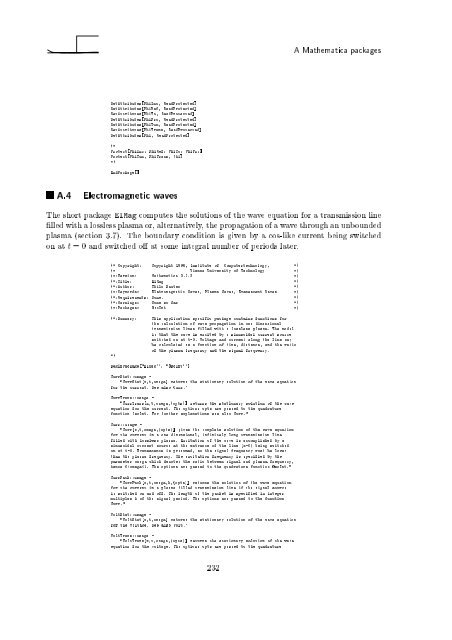Wave Propagation in Linear Media | re-examined
Wave Propagation in Linear Media | re-examined
Wave Propagation in Linear Media | re-examined
Create successful ePaper yourself
Turn your PDF publications into a flip-book with our unique Google optimized e-Paper software.
SetAttributes[PhiInc, ReadProtected]<br />
SetAttributes[PhiRef, ReadProtected]<br />
SetAttributes[PhiTo, ReadProtected]<br />
SetAttributes[PhiFro, ReadProtected]<br />
SetAttributes[PhiTun, ReadProtected]<br />
SetAttributes[PhiTrans, ReadProtected]<br />
SetAttributes[Phi, ReadProtected]<br />
(*<br />
Protect[PhiInc, PhiRef, PhiTo, PhiFro]<br />
Protect[PhiTun, PhiTrans, Phi]<br />
*)<br />
EndPackage[]<br />
A.4 Electromagnetic waves<br />
A Mathematica packages<br />
The short package ElMag computes the solutions of the wave equation for a transmission l<strong>in</strong>e<br />
lled with a lossless plasma or, alternatively, the propagation of a wave through an unbounded<br />
plasma (section 3.7). The boundary condition is given by a cos-like cur<strong>re</strong>nt be<strong>in</strong>g switched<br />
on at t = 0 and switched o at some <strong>in</strong>tegral number of periods later.<br />
(* Copyright: Copyright 1996, Institute of Computertechnology, *)<br />
(* Vienna University of Technology *)<br />
(*:Version: Mathematica 2.2.3 *)<br />
(*:Title: ElMag *)<br />
(*:Author: Thilo Sauter *)<br />
(*:Keywords: Eletromagnetic <strong>Wave</strong>s, Plasma <strong>Wave</strong>s, Evanescent <strong>Wave</strong>s *)<br />
(*:Requi<strong>re</strong>ments: None. *)<br />
(*:Warn<strong>in</strong>gs: None so far *)<br />
(*:Packages: OscInt *)<br />
(*:Summary: This application specific package conta<strong>in</strong>s functions for<br />
the calculation of wave propagation <strong>in</strong> one dimensional<br />
transmission l<strong>in</strong>es filled with a lossless plasma. The model<br />
is that the wave is excited by a s<strong>in</strong>usoidal cur<strong>re</strong>nt source<br />
switched on at t=0. Voltage and cur<strong>re</strong>nt along the l<strong>in</strong>e may<br />
be calculated as a function of time, distance, and the ratio<br />
of the plasma f<strong>re</strong>quency and the signal f<strong>re</strong>quency.<br />
*)<br />
Beg<strong>in</strong>Package["ElMag`", "OscInt`"]<br />
CurrStat::usage =<br />
"CurrStat[x,t,omega] <strong>re</strong>turns the stationary solution of the wave equation<br />
for the cur<strong>re</strong>nt. See also Curr."<br />
CurrTrans::usage =<br />
"CurrTrans[x,t,omega,(opts)] <strong>re</strong>turns the stationary solution of the wave<br />
equation for the cur<strong>re</strong>nt. The options opts a<strong>re</strong> passed to the quadratu<strong>re</strong><br />
function OscInt. For further explanations see also Curr."<br />
Curr::usage =<br />
"Curr[x,t,omega,(opts)] gives the complete solution of the wave equation<br />
for the cur<strong>re</strong>nt <strong>in</strong> a one dimensional, <strong>in</strong>f<strong>in</strong>itely long transmission l<strong>in</strong>e<br />
filled with lossless plasma. Excitation of the wave is accomplished by a<br />
s<strong>in</strong>usoidal cur<strong>re</strong>nt source at the entrance of the l<strong>in</strong>e (x=0) be<strong>in</strong>g switched<br />
on at t=0. Evanescence is p<strong>re</strong>sumed, so the signal f<strong>re</strong>quency must be lower<br />
than the plasma f<strong>re</strong>quency. The excitation f<strong>re</strong>quency is specified by the<br />
parameter omega which denotes the ratio between signal and plasma f<strong>re</strong>quency,<br />
hence 0












